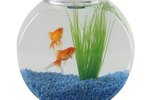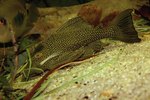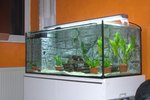
Ammonia burn is one of the problems associated with high levels of ammonia in an aquarium. The excess ammonia burns the fish’s skin, gills and fins, causing a reddish discoloration that eventually turns black as the spots start to heal. However, if the fish continue to be exposed to high levels of ammonia then the condition will not improve and will result in additional health problems for saltwater fish.
Ammonia in the Aquarium
Fish produce ammonia as part of their digestive process, then release that ammonia from their bodies as waste. In a properly maintained aquarium, ammonia levels remain in check and do not cause problems for fish. However, several problems can cause high ammonia levels. For example, overfeeding fish can cause them to produce larger quantities of waste so more ammonia ends up in the water. Also, too many fish in one aquarium, not properly cycling the aquarium’s water and failing to clean the aquarium appropriately can cause unhealthy increases in ammonia levels.
Quick Reduction of Ammonia Levels
In saltwater aquariums with excessive ammonia levels, two corrective options are available. First, the water can be replaced. Although changing less than 10 percent of the water at a time is recommended for normal maintenance, high ammonia levels require changing at least 25 to 50 percent of the water. To change the water, siphon out the water and rinse off all of the hoses and filters thoroughly. Mix a commercial saltwater mixture with water and slowly add it back into the tank once it reaches the same temperature as the remaining aquarium water. Second, zeolites can be added to the water. Aquarium supply stores sell zeolites as crystals or cartridges that can be added to the water. Zeolite molecules are designed to combine with other molecules that they come in contact with. As a result, the zeolite molecules can absorb the ammonia molecules in the water which will reduce dangerous levels of the chemical in the aquarium. Once the ammonia levels return to normal, the saltwater fish suffering from ammonia burn should begin to heal on their own.
Preventing Ammonia Burns
To prevent ammonia burns or ammonia poisoning, take some precautions. First, test the aquarium water tested weekly. If ammonia levels seem to be creeping up, make corrections before the health of the fish suffers. Second, change approximately 10 to 20 percent of the water every two weeks. During this water change, the gravel also needs to be vacuumed. Otherwise, fish waste can build up around the gravel and be released into the water when the gravel is disturbed causing a spike in ammonia levels. Additionally, do not overstock an aquarium and always follow recommended feeding guidelines for saltwater fish species.
Other Ammonia-Related Health Concerns
In addition to ammonia burns, high levels of ammonia can cause other problems for saltwater fish. Too much ammonia can cause skin bruising, excessive mucus production, breathing problems and even death. Although ammonia burns may be the most noticeable sign of a problem, other symptoms include loss of appetite, reduced movement, inflammation of the eyes or gills and appearing to gasp at the water's surface .
References
Photo Credits
-
Jupiterimages/Photos.com/Getty Images
Writer Bio
Amy Jorgensen has ghostwritten more than 100 articles and books on raising and training animals. She is also an amateur dog trainer. She has also written more than 200 blog posts, articles, and ebooks on wedding and party planning on behalf of professionals in the field.



